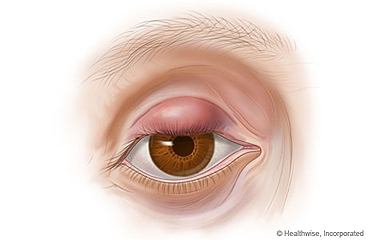
Overview
Styes and chalazia (say "kuh-LAY-zee-uh") are both conditions that can cause swelling of the eyelid.
A stye is an infection in the root of an eyelash. The infection causes a tender red lump on the edge of the eyelid. The infection can spread until the whole eyelid becomes red and inflamed. Styes usually break open, and a tiny amount of pus drains. They usually clear up on their own in about a week, but they sometimes need treatment with antibiotics.
A chalazion is a lump or cyst in the eyelid (chalazion is singular; chalazia is plural). It is caused by swelling and inflammation of deep oil glands inside the eyelid. Chalazia are usually not infected. They can take a few months to heal.
If a chalazion becomes more swollen and painful or does not go away, you may need to have it drained by your doctor.
Follow-up care is a key part of your treatment and safety. Be sure to make and go to all appointments, and call your doctor if you are having problems. It's also a good idea to know your test results and keep a list of the medicines you take.
How can you care for yourself at home?
- Do not squeeze or try to open a stye or chalazion.
- To help a stye or chalazion heal faster:
- Put a warm, moist compress on your eye for 5 to 10 minutes, 3 to 6 times a day. Heat often brings a stye to a point where it drains on its own. Keep in mind that warm compresses will often increase swelling a little at first.
- Do not use hot water or heat a wet cloth in a microwave oven. The compress may get too hot and can burn the eyelid.
- If the doctor gave you antibiotic drops or ointment, use the medicine exactly as directed. Use the medicine for as long as instructed, even if your eye starts to feel better.
- To put in eyedrops or ointment:
- Tilt your head back, and pull your lower eyelid down with one finger.
- Drop or squirt the medicine inside the lower lid.
- Close your eye for 30 to 60 seconds to let the drops or ointment move around.
- Do not touch the ointment or dropper tip to your eyelashes or any other surface.
- Do not wear eye makeup or contact lenses until the stye or chalazion heals.
- Do not share towels, pillows, or washcloths while you have a stye.
What can you do to prevent styes and chalazia?
Here are some things you can do to prevent styes and chalazia.
- Don't rub your eyes. This can irritate your eyes and let in bacteria. If you need to touch your eyes, wash your hands first.
- Protect your eyes from dust and air pollution when you can. For example, wear safety glasses when you do dusty chores like raking or mowing the lawn.
- Remove eye makeup before you go to sleep. Replace eye makeup, especially mascara, at least every 6 months. Bacteria can grow in makeup.
- If you get styes or chalazia often, wash your eyelids regularly with a little bit of baby shampoo mixed in warm water.
- Treat any inflammation or infection of the eyelid promptly.
When should you call for help?
Call your doctor now or seek immediate medical care if:
- You have pain in your eye.
- You have a change in vision or loss of vision.
- Redness and swelling get much worse.
Watch closely for changes in your health, and be sure to contact your doctor if:
- Your stye does not get better in 1 week.
- Your chalazion does not start to get better after several weeks.
Where can you learn more?
Go to http://www.healthwise.net/patientEd
Enter C853 in the search box to learn more about "Styes and Chalazia: Care Instructions".
Current as of: June 5, 2023
Author: Healthwise Staff
Clinical Review Board
All Healthwise education is reviewed by a team that includes physicians, nurses, advanced practitioners, registered dieticians, and other healthcare professionals.

